I hope you follow this guide to growing sugar snap & snow peas 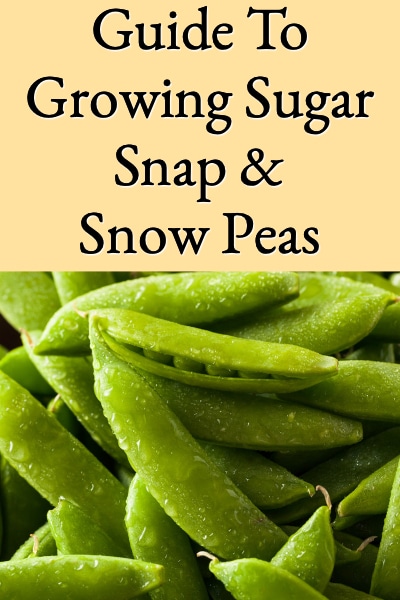
Peas are one of the world’s oldest crops and have been grown and eaten by humans for thousands of years. But, the Sugar Snap edible-podded pea wasn’t introduced until the late 1970s, when its crisp, juicy, and intensely sweet taste started a pea resurgence.
Many gardeners are growing peas for the first time because sugar snap peas do not require shelling and are so delicious. These peas also convert their sugar to starch so fast that great edible-podded peas aren’t available at the grocery store; their fantastic flavor and sweetness are only truly experienced fresh from the garden.
The good news is that they’re easy to grow, one of spring’s earliest crops, and don’t require much space. Peas are a natural for small gardens because they’re vining vegetables. You can grow them vertically by using poles and string to create a teepee, cattle panels made into an A-frame, or use recycled items such as old futon frames, discarded baby gates, and old ladders.
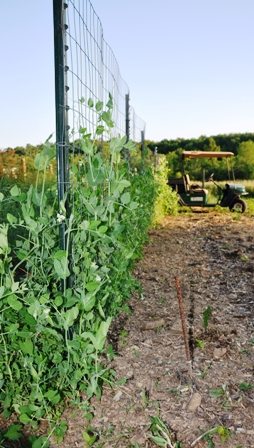
Sugar Snaps Growing On Fencing
Guide To Growing Sugar Snap & Snow Peas (Edible Podded Peas)
What Are Edible Podded Peas?
Peas are members of the legume family, and the plants produce pods that contain edible seeds. There are two main types of peas: garden peas and edible-podded peas. Garden peas produce sweet seeds, but the pods are not edible so the peas are shelled and only the seeds are eaten. Edible podded peas have tender pods that do not need shelling, so both pod and seeds are eaten.
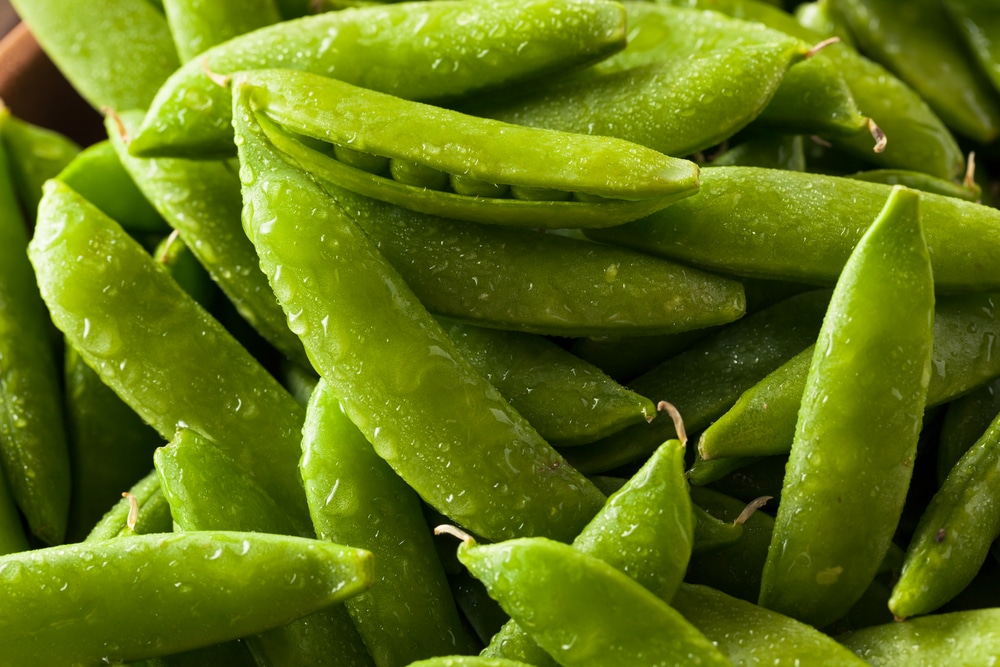
Sugar Snap Peas
There are also two main types of edible-podded peas, commonly referred to as snow peas and sugar snap peas. Sugar snap peas have fuller, fatter pods with individual peas inside that are allowed to develop more than the individual peas in snow peas. All edible-podded peas are tender and sweet when eaten fresh, or they can be sauteed, stir-fried, or steamed.
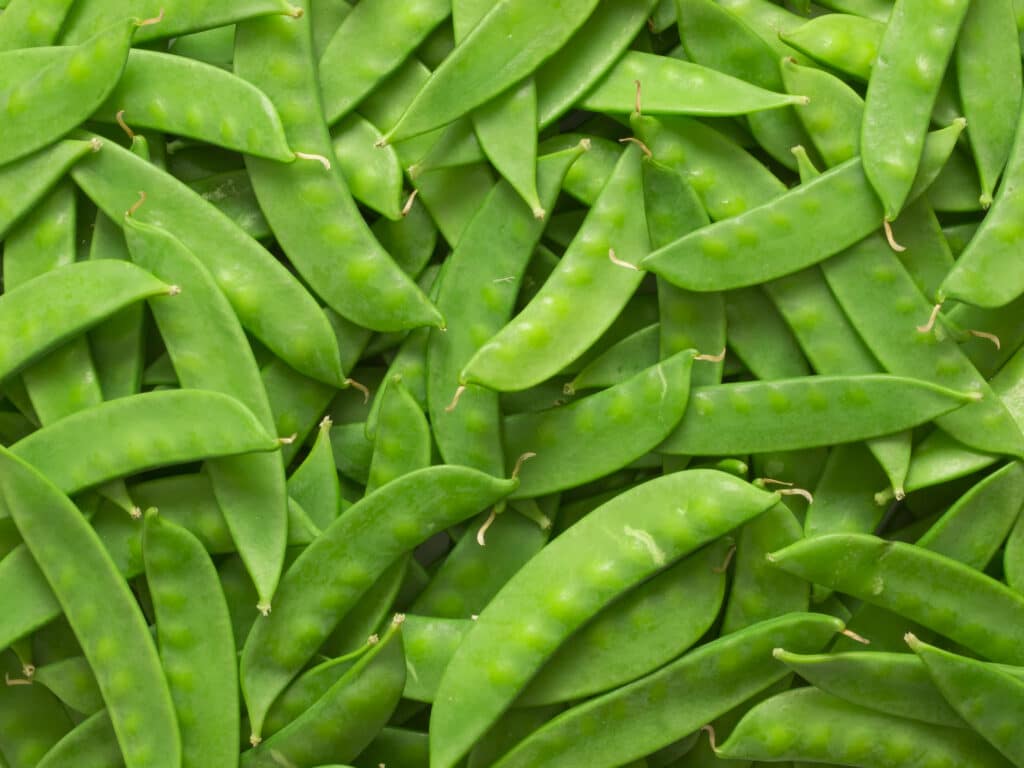
Snow Peas
Peas originated in the Mediterranean, and in Asia, were selected for their succulent tender pods, leading to the varieties we know today as snow peas. Dr. Calvin Lamborn developed the sugar snap pea by crossing thick fleshed garden peas with edible-podded varieties to obtain a plant that produced large, sweet peas and crisp pods. He named it “Sugar Snap” and upon its introduction in 1979, it immediately became an All American Selection (AAS).
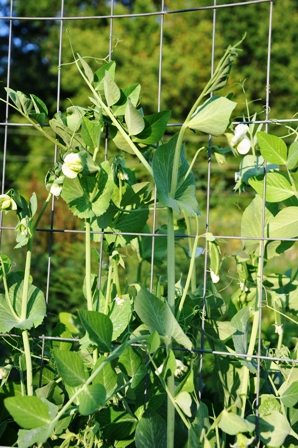
Sugar Snap Peas In Bloom
Sugar Snap & Snow Pea Varieties
Today, there are several good varieties of both snow and sugar snap peas commonly available. The most popular varieties of snow pea are Oregon Giant, Oregon Sugar Pod II, and Mammoth Melting Sugar. Popular varieties of sugar snaps include Sugar Ann, Sugar Sprint, Sugar Snap, and Super Sugar Snap.
The varietal descriptions in seed catalogs identify whether they’re bush or tall vining plant types, and this determines whether they need trellising. The tall types will generally exceed six feet in height and need trellises, whereas the smaller bush types grow 2 – 3 feet high and can be grown with or without supports. Peas vines are extremely light, so you can use the most basic structures as support. Lightweight netting and twine work fine.
The bush types usually mature sooner and bear over a shorter period than the tall types, and are less productive overall. You can get the best of both types by planting the bush and tall types together, that way you get the earliness of the bush types along with the continuing harvest from the tall types. For taste, the original Sugar Snap still has great flavor (in my opinion), so the tall Sugar Snap and bush Sugar Ann are the varieties we grow in the garden.
When To Grow Sugar Snap & Snow Peas
Edible podded peas are cool-season vegetables, so they are usually planted early in the spring, 2 – 6 weeks before the last frost date, or when the soil temperature reaches at least 45°F. Additional plantings can be made through early spring, but edible-podded peas grow best in 60° – 65°F daytime temperatures and do not tolerate hot summer temperatures.
They can be planted again for fall harvest in late summer (8 weeks before the first frost date). In warmer Southern regions, peas are best grown from fall to spring.
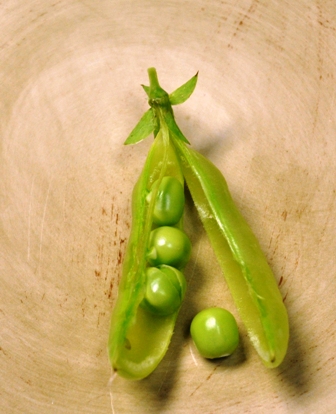
Freshly Harvested Sugar Snap Pea
How To Plant Peas
Peas can be started indoors, but it’s much easier to plant them in their permanent spot outdoors. For small space gardens, you can plant the seeds 1″ deep and 4″ apart in organically rich soil. That may sound like they’re closely spaced but they do fine if they’re in well-prepared soil where there is good air circulation. For traditional garden beds, plant seeds 1-2 inches apart in rows 18 inches apart.
Peas should be planted in soil that receives at least six hours of sun each day, and that has a pH of 6.0 – 7.0. The seeds can be treated with legume inoculant prior to planting, it’s not required, but will improve growth and yields. Peas fix nitrogen in the soil where they are grown and produce pretty edible flowers and shoots, so don’t limit planting to just garden beds. Tuck peas into borders, pots, and hanging containers anywhere there is sun to create beautiful edible landscapes.
Caring For Sugar Snap & Snow Peas
After germination, peas grow rapidly, so it’s a good idea to get trellis material in place right away. Avoid planting peas in the same spot more than once every four years to minimize the potential for pests and disease (see Garden Crop Rotation – A Simple System). Also, avoid high-nitrogen fertilizers since too much nitrogen will result in lush foliage but poor flowering and fruiting.
Peas need about an inch of water a week, and weeds should be removed so that they don’t compete with the peas. When watering, avoid wetting the foliage if possible to avoid disease. Peas will reach maturity in 50 – 70 days depending on the variety and growing conditions.
Harvesting Your Peas
Snow peas should be harvested when the internal peas are tiny but the pods are fully developed, whereas sugar snaps are harvested when the pods are plump and have reached full size. After picking – eat, refrigerate, or freeze the peas quickly, as half of their sugar content will turn to starch within six hours at room temperature.
Before eating, some pea varieties need to be ‘strung’ to remove the membrane running along the tip of the pod. To ‘string’ peas, snip off the tip of the pod, then pull along the length of the pod to remove the stringy portion.
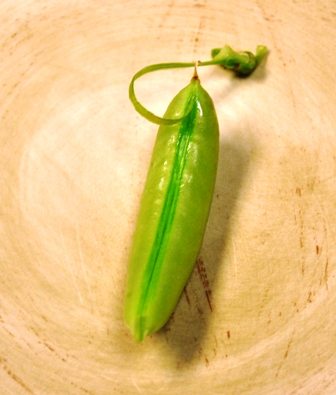
Stringing A Sugar Snap Pea
One bite into a crisp, sweet, crunchy sugar snap pea fresh from the garden will convince anyone that these spring treasures are so delicious and easy; every garden should have them!
And if you run into a bumper crop of peas, try this recipe (Sesame Sugar Snap Peas) for a variation everyone seems to love.
Sugar Snap & Snow Pea Seed Sources:
- Baker Creek Heirloom Seed (www.rareseeds.com) – Snow Peas (Oregon Sugar Pod II and Green Beauty), Sugar Snaps (Sugar Snap, Sugar Daddy, and Sugar Bon.
- Burpee Seeds (www.burpee.com) – Snow Peas (Mammoth Melting Sugar, Sugar Prince, Snowbird, Oregon Sugar Pod II), Snap Peas (Super Snappy, Sugar Magnolia, Super Sugar Snap, Sugar Snap)
- Johnny’s Selected Seeds (www.johnnyseeds.com) – Snow Peas (Oregon Giant, Avalanche, Royal Snow, and Golden Sweet), Sugar Snaps (Sugar Ann, Sugar Snap, Royal Snap II, and Honey Snap II)
Iris Thomas says
I would keep the dried peas for planting next year. Take them out of the pod and store them where they will stay dry and you should be able to plant them next year.
Iris Thomas says
Aside from spring, most gardeners, regardless of where in the country they live (colder or warmer), get to plant a second round of these crops in the fall. Specifically, the perfect time to plant snap peas is in late summer, at least 8-10 weeks before the first frost in your region.
Lesa says
Hi Iris,
I’m definitely going to follow your advice and try a second round of these peas this fall. They are just so good!